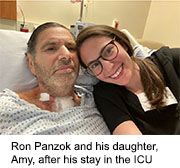
For Ron Panzok and many patients like him, the battle with COVID-19 didn’t end when he left the hospital.
From the ambulance ride to North Shore University Hospital on New York’s Long Island to the day he finally woke from a medically induced coma five weeks later, Panzok doesn’t remember a thing. He missed more than a month of his life.
But emerging from the coma was only the start of a long road to recovery. The left side of his body was paralyzed — the likely result of being sedated for weeks and a possible sign of nerve damage, which studies have shown coronavirus can cause.
“When I woke up from the coma, I could talk and everything, but I got scared because I couldn’t move my left hand — and I’m a lefty,” said Panzok, a 66-year-old trucker from Queens, N.Y. “My hand was completely useless, and I couldn’t move anything on my left side.”
In mid-May, two weeks after he woke and got off a ventilator, Panzok was transferred to an acute rehab facility at Glen Cove Hospital, also on Long Island.
Acute rehabs take in patients after they leave a hospital’s intensive care unit. Typically, patients have recovered from the injury or condition that sent them to the hospital — be it a stroke, spinal cord injury or loss of a limb — but they still have significant disabilities.
When Panzok got to Glen Cove, his kidney function was low and he was receiving dialysis. He had a deep pressure sore, a common injury among people who are bedridden. He still had paralysis on his left side and weakness throughout his body.
His arrival at the rehab center was well-timed. As the coronavirus cases peaked in New York, Glen Cove designated half of its rehab beds for COVID-19 patients.
“We basically ended up physically splitting our rehab units into two so that we could safely provide COVID rehab,” said Dr. Susan Maltser, medical director of the hospital’s department of physical medicine and rehabilitation.
More help for COVID-19 patients
At Glen Cove, Panzok and other COVID-19 patients worked with an array of specialists to regain abilities damaged by their illnesses. They include physical and occupational therapists, speech and swallowing therapists, psychologists and social workers.
“Acute rehab is all about restoring independence, function and quality of life to a patient’s previous life, before whatever injury you had,” Maltser said.
After fighting COVID-19, many patients struggle to walk or even turn over in their beds. Physical therapists help them regain the strength to do those everyday tasks independently.
Since the new coronavirus can ravage the lungs, many patients arrive at rehab needing oxygen to breathe. Respiratory therapists help them recover their lung function.
For those who lose the ability to speak, perhaps due to a stroke suffered during their illness, there is speech therapy.
And many COVID-19 patients suffer emotionally, too. That was especially true for those like Panzok who arrived at Glen Cove in spring or early summer, when New York hospitals banned visitors. Many patients hadn’t seen their family in weeks or months and were struggling.
“Many of these patients had almost like post-traumatic stress disorder,” Maltser said. “When you go through something like this, and you’ve been alone in the hospital with no family, it’s very difficult.”
But many of the problems affecting COVID-19 patients are familiar for rehabilitation centers, as spending time in an intensive care unit can have similar effects on people regardless of their condition.
“There’s something that happens to the body when you’re in a ventilator for a prolonged period of time,” Maltser explained. “If you’re unable to walk, your muscles get deconditioned.”
Surprises during recovery
But, as is to be expected with a virus that scientists are still trying to understand fully, there have been surprises from those recovering from COVID-19.
Dr. Sean Smith is an assistant professor of physical medicine and rehabilitation at Michigan Medicine in Ann Arbor.
Before the pandemic, he said, the recovery of patients who make it to rehab after time in the intensive care unit is generally an upward trajectory. With the coronavirus, there are more ups and downs.
Even after testing negative twice for the virus — a popular protocol before entering an acute rehab facility — some patients develop blood clots, Smith said.
“After they’ve been stable for a week, all of a sudden that just happens out of nowhere,” he said. “It’s not always obvious that these patients are still in a hypercoagulable and hyperinflammatory state.”
The fact is that the virus affects people differently, added Maltser.
And Panzok was one of the lucky ones, as his health is much better now.
He left Glen Cove in late May, after two weeks of care. By the time he left, his kidneys had recovered enough that he no longer needed dialysis. He had also regained much of his ability to move his left side.
He still gets jolted awake some nights by shooting pain and numbness in his left foot — remnants of the nerve damage he endured.
And Panzok said his body is no longer strong enough to manage the manual labor that goes along with his work as a self-employed trucker.
Still, his positive spirit has held steady, which he credits in helping along his recovery.
“Attitude is very important,” Panzok said. “I saw people that didn’t want to move in the rehab, but you have to fight and fight.”
More information
There’s more about coronavirus at the U.S. Centers for Disease Control and Prevention.
Source: HealthDay
Copyright © 2024 HealthDay. All rights reserved.

Leave a Reply